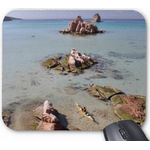While in San Juan our iWap-23, the universal battery charger we are carrying, breaks down. We use it to charge the batteries for the Nikon and the Fujifilm 3D cameras, the head lights and the GPS. So far it has worked wonderfully and saves us from carrying individual chargers for each of the cameras and an additional one for the AA and AAA batteries. Without the iWap we cannot charge anything. We call the customer service in the U.S. and the decision is to buy another one and return the one we have, since it’s still under warranty. The shipment will take about 5 days, so we give them the address of the hostel where we will stay in Tucumán. We planned to take a bus to Tucumán today, but as this city doesn’t have much interest, we will make a better use of our time visiting two parks near San Juan: Ischigualasto and Talampaya (the latter is actually in the neighboring province of La Rioja). It seems it was our destiny to visit them. After much thinking we had decided to not visit them. These parks are located approximately 200 mi North of San Juan and as we saw in the previous stage, the landscape of these provinces is not too interesting, except for specific locations. So before the charger broke, we had decided to take the bus to Tucumán and to not visit them. Fate has favored us because the two are spectacular, especially Talampaya.
June 1, 2011: Ischigualasto Provincial Park
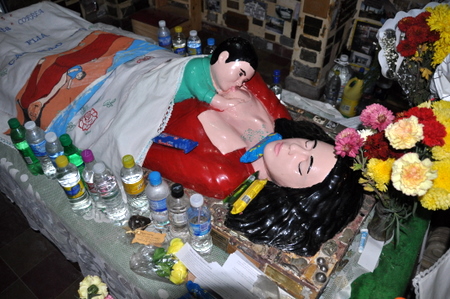 We rent a car in San Juan and head to Ischigualasto, in the northeastern border with La Rioja. En route we pass the shrine of the Deceased Correa. This is a place of pilgrimage similar to the one for the Virgin of Lourdes in France. Once a year, several groups of gauchos make the journey on horseback from their cities to here. They have even built a bike path parallel to the road for pedestrians and cyclists. The bike path is a luxury, paved with painted lines and signs of change of gradient. Of course, the current authorities do use the opportunity to show themselves around and remind everyone how well they are doing their job. Around the shrine, all the services the devotees may need are present, from large parking areas to restaurants and places to buy all sort of objects of worship. Obviously, there is also a Church for religious celebrations.
We rent a car in San Juan and head to Ischigualasto, in the northeastern border with La Rioja. En route we pass the shrine of the Deceased Correa. This is a place of pilgrimage similar to the one for the Virgin of Lourdes in France. Once a year, several groups of gauchos make the journey on horseback from their cities to here. They have even built a bike path parallel to the road for pedestrians and cyclists. The bike path is a luxury, paved with painted lines and signs of change of gradient. Of course, the current authorities do use the opportunity to show themselves around and remind everyone how well they are doing their job. Around the shrine, all the services the devotees may need are present, from large parking areas to restaurants and places to buy all sort of objects of worship. Obviously, there is also a Church for religious celebrations.
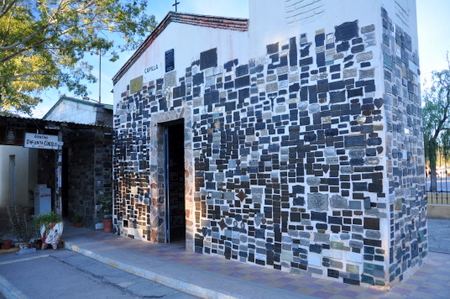 The sanctuary is in a fenced compound that includes several small chapels. The walls of the chapels are covered with plaques signed by believers thanking the Difunta Correa for granting their requests. Inside the chapels there are all kinds of objects, statues, photographs and writings related to the granted favors. Among the most curious we see car license plates, competitions trophies, models of houses and even a truck engine. To read more about the Difunta Correa story, go to our episode of Aconcagua Provincial Park.
The sanctuary is in a fenced compound that includes several small chapels. The walls of the chapels are covered with plaques signed by believers thanking the Difunta Correa for granting their requests. Inside the chapels there are all kinds of objects, statues, photographs and writings related to the granted favors. Among the most curious we see car license plates, competitions trophies, models of houses and even a truck engine. To read more about the Difunta Correa story, go to our episode of Aconcagua Provincial Park.
The provincial road leading to Ischigualasto passes through villages scattered throughout the Fertile Valley. It's not precisely a garden, but compared to the dryness of other parts of the province it could be called so. The landscape is composed of bushes and carob trees. It begins to get dark and driving becomes more dangerous. Not because of the traffic, since it’s practically nonexistent, but for animals that inhabit the area. We see all sorts of species in the middle of the road: foxes, cows, goats, horses, dogs... We finally arrive in St. Augustin where we camp.
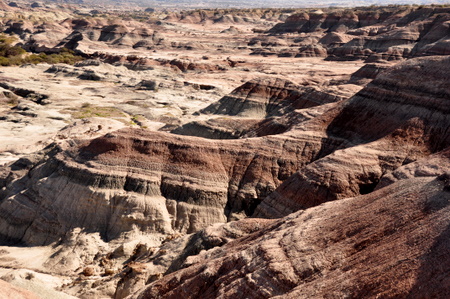 Towards noon of the next day we reach the park’s visitor center and wait until the caravan of cars is formed. We will follow the guide´s vehicle along an established route, stopping at a number of points where we will listen to his explanations. Presumably, this serves to preserve the fragile environment, but gives no flexibility to explore the park according to personal interests. The park is famous for its rock formations caused by erosion which have been given evocative names as The Worm, The Submarine, The Mushroom, etc.. However, the best known, and that often replaces the real name of the park is the Valley of the Moon. Both the sandstone formations and the layers of different colors of the Valley of the Moon are spectacular. Another strange rock formation found here is the Cancha de Bochas (Ball Court). These are almost perfectly spherical rocks that are concentrated in a small area.
Towards noon of the next day we reach the park’s visitor center and wait until the caravan of cars is formed. We will follow the guide´s vehicle along an established route, stopping at a number of points where we will listen to his explanations. Presumably, this serves to preserve the fragile environment, but gives no flexibility to explore the park according to personal interests. The park is famous for its rock formations caused by erosion which have been given evocative names as The Worm, The Submarine, The Mushroom, etc.. However, the best known, and that often replaces the real name of the park is the Valley of the Moon. Both the sandstone formations and the layers of different colors of the Valley of the Moon are spectacular. Another strange rock formation found here is the Cancha de Bochas (Ball Court). These are almost perfectly spherical rocks that are concentrated in a small area.

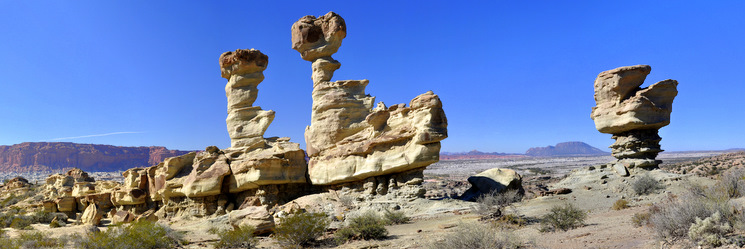
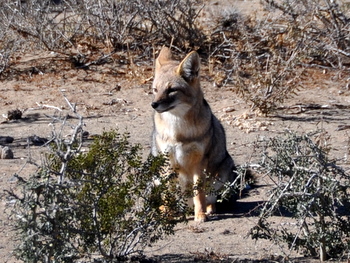 The park contains a high concentration of fossils, some of which are displayed in a small museum. Among the most important pieces is the skeleton of a Herrerasaurus Ischigualastensis. In fact, the park was declared a World Heritage Site for being an open book for geologists and paleontologists. Along its surface there are strata for 4 of the 7 stages of the Triassic period, the first of the Mesozoic era (see Table of geological periods). This makes it a unique place on the planet. Beyond the borders of the park, in the province of La Rioja, continues the Natural World Heritage Site with the rest of the strata for that period, within the Talampaya park boundaries, our next visit.
The park contains a high concentration of fossils, some of which are displayed in a small museum. Among the most important pieces is the skeleton of a Herrerasaurus Ischigualastensis. In fact, the park was declared a World Heritage Site for being an open book for geologists and paleontologists. Along its surface there are strata for 4 of the 7 stages of the Triassic period, the first of the Mesozoic era (see Table of geological periods). This makes it a unique place on the planet. Beyond the borders of the park, in the province of La Rioja, continues the Natural World Heritage Site with the rest of the strata for that period, within the Talampaya park boundaries, our next visit.
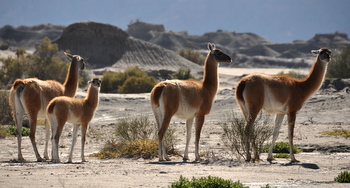 During the drive along the park we run across a couple of herds of guanacos and a fox, common inhabitants of the place.
During the drive along the park we run across a couple of herds of guanacos and a fox, common inhabitants of the place.
Go to top
© 2014 Explore Pangea. All Rights Reserved. Website
Terms
of Use.









